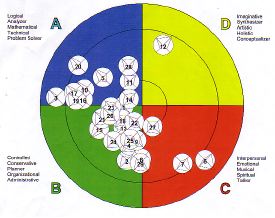
Contact Manager
Phone:
+64 21 620 456
16 Kauri Street, Woburn, Hutt City, New Zealand
email:
Manager@virtual.co.nz
 |
Understanding ourselves and our customers
One of the first things I did was to get the Corporate Services people into groups according to their Herrmann profiles. Participants had been asked to read a paper about the theory of Herrmann and to complete their own profiles before coming to the workshop. I was therefore able to get people to move immediately into the four corners of the room according to their preference in thinking.

Each team was asked to show with their bodies and without talking what it was like to be them - what they valued, what was important to them, how it felt to be someone with a thinking preference of their type. As each team did its performance the other three groups were asked to observe closely what they saw and report back these observations. Hereís what they saw:
The As (the thinkers), formed into a straight line and moved determinedly towards their goal. The supervisor kept everyone in line and they showed, by other symbols, qualities such as questioning, analysing, thinking and measuring.
The Bs ( the organisers) spent quite a bit of their preparation time trying to plan their activity in silence. The ban on talking actually started only at the point when they started their presentation, but the Bs were so good at following rules that they took quite a while before they questioned why other teams seemed to be talking. During their presentation, which they achieved very quickly once they got started, they went through a very structured process starting with one person and proceeding through the process person by person until the process came to a conclusion. Somebody was watching the time and the activity was tightly controlled and restricted. It was exactly what one would expect from this type of thinking preference.
The Cs ( the humanitarians) had a great time deciding what to do. They sat in a circle on the floor in an informal way, laughing and with loads of involvement. During their presentation they showed a great deal of love and teamwork, coming together, sharing things, touching, caring and laughter. There was no doubt from the way they behaved that people mattered most.
The Ds (the innovators) spent almost the whole of their preparation time arguing about what to do. They didn't come to any conclusions until the last 30 seconds at which point with unbelievable creativity and intuition they strung together a performance which showed people out exploring, challenging the status quo, questioning, disrupting things, destroying bureaucracy and eliminating rules.
The wonderful thing about this simple exercise is that people see, right from the start of the workshop, that people are different. The exercises show without question that whatís important to one group is far less important to the other groups. No amount of pushing or pulling or hoping will make one group value the things that the other groups value. The discussion that followed this insight showed that this is not a problem unless we donít understand it. With understanding, people start to see that instead of differences being a problem, they are a strength and even a necessity. Without the other quadrants we simply donít see all the world but only the things that we value and relate to.
The other thing that this exercise does, is to very quickly show people roughly what the weighting of the group is. For instance, in this Department , we found that there was (as expected) a large number of As and Bs but what was surprising, for me at least, was the unexpected number of Cs. This led to discussions about why this Corporate Services team was different from most similar teams Iíve worked with. Clearly it has something to do with them being a part of an organisation with a broad social role.
As follow-up exercises, we went on to use Herrmann to help show people what their innate talents were and how they should develop these to become even stronger. We used Herrmann to show how each of the work teams (Accounting Team etc.) was constructed and what its strengths and weaknesses were likely to be. We also used Herrmann to think about each team's key customer groups and how these customers should be approached and communicated with in order to work most effectively with them.


